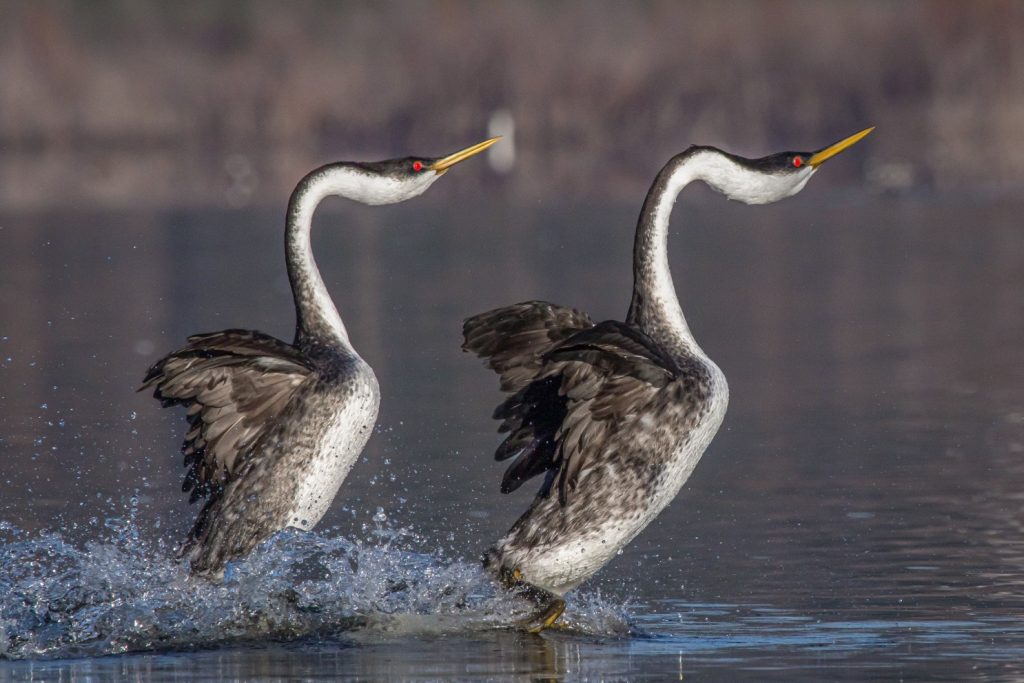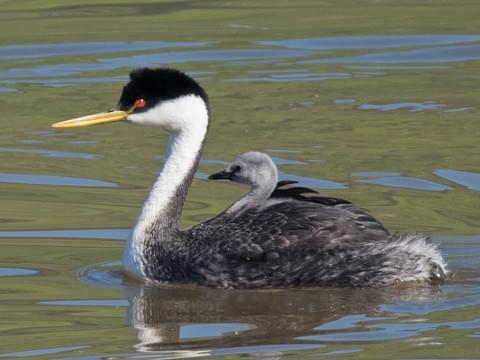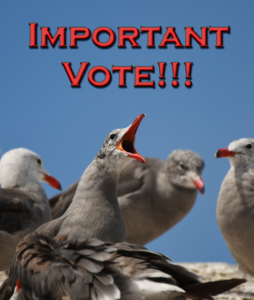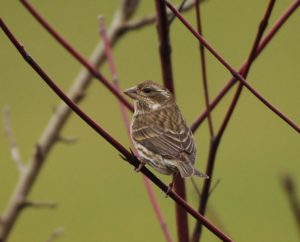By Sharon Moore
Order: Podicipediformes
Family: Podicipedidae

This lovely water bird is an elegant presence riding high on the surface, giving the impression that it’s always on “high alert.” Its red eyes and yellow bill stand out against its definitive black and white plumage helping us to easily identify the bird. With a body 25 inches long punctuated by a wingspan of 24 inches, the Western Grebe’s extended neck and long, thin bill make clear this is a strong diving, fishing species.
Highly gregarious, Western Grebes tend to form large colonies, called “rafts,” of hundreds of individuals in spring congregating on expansive fresh water lakes with adequate marsh vegetation for nesting during the breeding season. In winter, however, we more commonly hear their “kreet” calls and see them from September to May navigating the Pacific coast estuaries and bays as well as Puget Sound inlets. During these months they stay fairly close to shore, often easy to see especially with a spotting scope. Rarely seen on land unless they’re blown down in storms, they are also seldom visible in flight as they navigate only at night.
Western Grebes primarily eat fish during all seasons and in all habitats; however, they may also include, depending on availability, salamanders, insects, marine worms, grasshoppers and crabs in their diets. A surprising observation is that when they are preening they also eat their own feathers, which line their stomachs, helping protect against punctures by sharp fish bones. Though this may sound like a digestive nightmare, these birds can fortunately regurgitate pellets containing feathers, bones and other indigestible material. When feeding, they take long dives from the surface, swimming underwater, wings generally closed, propelled mainly by their feet. Unlike other grebe species, except the Clark’s, the Western Grebes have a structure in their necks that is thought to allow them to spear fish with rapid, piercing movements. Since the males have longer, thicker bills than the females, researchers posit that difference may allow females and males to feed on different-sized prey, thus reducing food competition between the sexes.
Breeding season arrives with fanfare for our Western Grebes. Though their feet are set far back on their bodies, rendering them awkward when out of the water, their courtship displays are anything but awkward. When pairs are bonding, they engage in stunning ballet-like, “running on water” breeding ceremonies. For specifics on these performances, refer to the Cornell Lab of Ornithology website at “All About Birds.” Once bonded, the couple begin their nesting activities. The male chooses the nesting site, generally in reeds or rushes near the water’s edge. The depth of the water is usually no more than one foot. Together, the pair works at constructing their nest which can be 2 to 3 feet in diameter or larger, essentially a mound of vegetation with a depression for the eggs in the center. Since the males are stronger and have larger bills they contribute the bulk of stalks and stems. The females add wet material such as algae to cement the nest and form the central depression. When complete, the nest is anchored to vegetation or a snag underwater to protect it from wind and wave action.

Female Western Grebes lay 2 to 4 eggs, which are 2 to 2.5 inches long and approximately 1.5 inches wide. Both sexes incubate the eggs for 24 days during which time the male feeds the female. Born alert, the hatchlings are covered with black and silver-colored down. Within minutes of hatching they climb onto the backs of their parents who feed them as they mature and begin to fly at ten weeks old. When the breeding season is over, the adults molt their wing feathers and, when new feathers appear, generally migrate in the fall to coastal habitats where fish stock is abundant.
As to our concern for the level of stability of the Western Grebe populations, the prognosis is complicated. Tragically, these birds were hunted to near extinction in the early 20th century for their dense, waterproof plumage, which was prized for the clothing and hat styles of the time. Though the species managed to make a long, slow recovery, it has not, in the ensuing ninety to one hundred years, ever regained its original numbers. The last scientific observation data, published in 2015, suggests that while some Western Grebe populations are stable, many are in slow decline. Although this species has benefitted from the creation of reservoirs and other wetlands in recent decades, the continuing loss of natural wetlands and extensive hunting have caused on-going declines. Add the problems of the species’ sensitivity to pesticides, oil spills, gill nets and human disturbance of nesting sites, and it’s clear these bird populations have been struggling. In more recent times another dimension – that of global warming effects – has begun to threaten our Western Grebes. Increasing wildfires may incinerate their nesting habitats and spring heat waves, from global temperature increases, will endanger the young in the nest. Faced with this plethora of encroachments on their survival, Western Grebes have less than a robust long-term future.
Should you want to locate Western Grebes in our general locale, Whittier Johnson, long time birder and BHAS member, offers the following suggestions. High numbers are often visible in rafts on Hood Canal. With a spotting scope you may see them in spring, fall and winter from Potlatch State Park or the pullout on the eastside of Hood Canal, a few miles north from Hunter Farms. You may also find them in waters around the Union Marina. At Westport, without a scope, you can check for Western Grebes at the boat basin and inside the marina. Common Loons are often present there as well. Also in Westport, without a scope, it’s possible to see the birds from the wooden viewing platform at the Harbor Resort end of the boat basin. Often, scoping for Western Grebes at the mouth of Grays Harbor is successful, across the water between Westport and the North Jetty at Ocean Shores. Of course you can also scan for the birds from the North Jetty across the water south to Westport. Enjoy your winter birding excursions.







